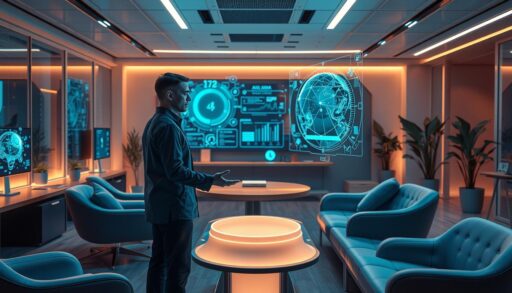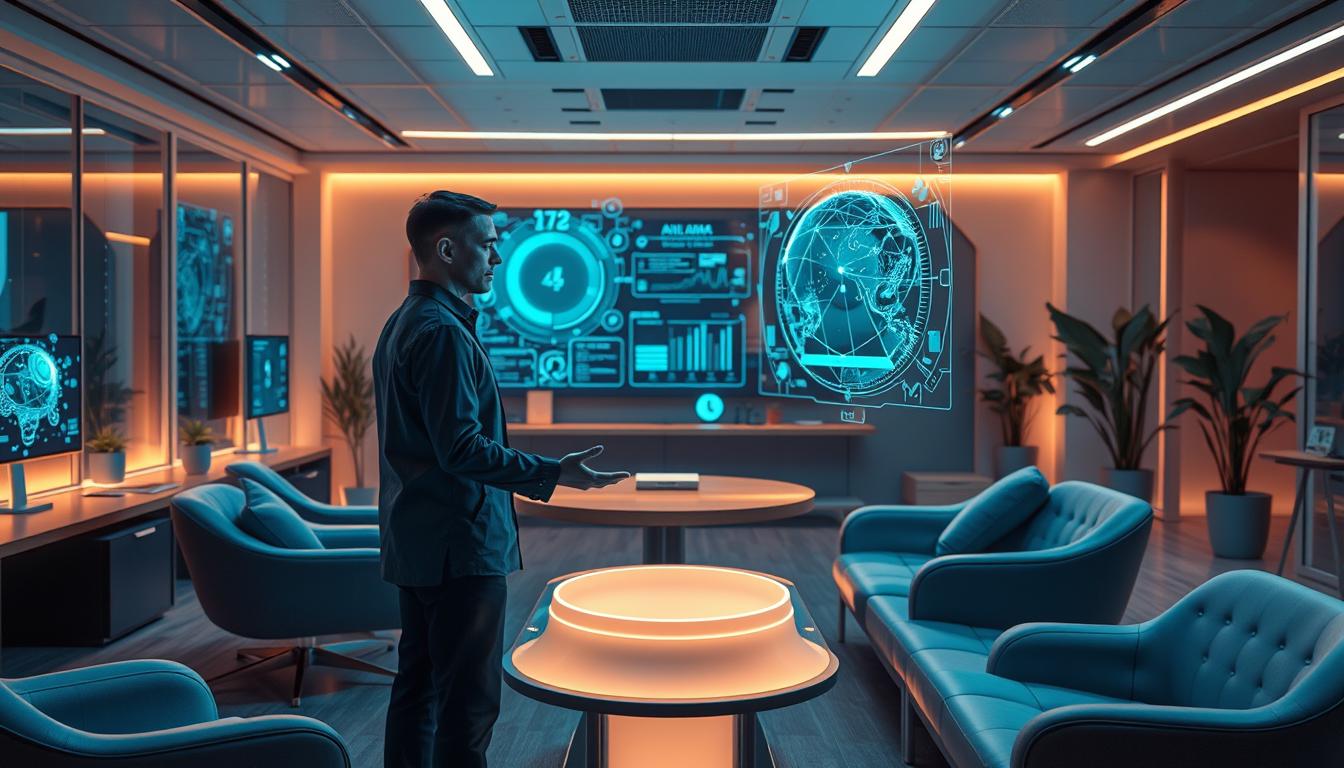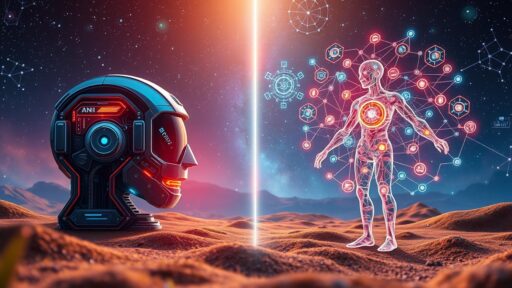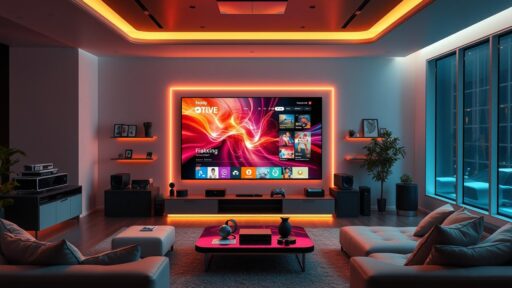I’ve seen a big gap between our digital tools and how well we use them. As tech gets better, interfaces get more complicated. This makes many users unhappy and stressed.
But, there’s a bright side. Artificial intelligence is changing how we use technology. It’s making interfaces smarter and more user-friendly. This means we can work better and feel less stressed.
Key Takeaways
- AI-powered interfaces boost user engagement by 22%
- 68% of AI-HCI apps prioritize user data security
- Human-centered AI development increases user trust by 87%
- 45% of organizations focus on user-centered design in AI-HCI
- AI enhances digital accessibility by 30% for users with disabilities
- 93% of successful AI-HCI projects use iterative design processes
Understanding the Fundamentals of AI and HCI
I’ve seen how AI and Human-Computer Interaction (HCI) have changed how we use technology. This field has grown a lot since the 1980s when personal computers became common.
Defining Human-Computer Interaction
HCI is a field that looks at how we use computer systems. It combines computer science, cognitive science, and human-factors engineering. The aim is to make interfaces easy to use and meet user needs.
The Role of Artificial Intelligence in HCI
AI has changed HCI by making interactions more natural. Natural language processing lets chatbots and virtual assistants understand and reply to human speech. This tech is now a big part of many devices.
Key Principles of User-Centered Design
User-centered design is key for making good AI-powered interfaces. It includes:
- Understanding user needs
- Doing deep user research
- Using an iterative design process
The mix of AI and HCI has led to more personalized experiences. For example, eye-tracking tech can now track visual attention well. This improves user interaction in many fields. With the Internet of Things set to hit 27 billion endpoints by 2025, AI will make our tech interactions even better.
Artificial Intelligence Human Computer Interaction: Revolutionizing User Experiences
I’ve seen AI change how we use technology. Voice interfaces like Alexa and Siri help us with our needs. They give us personalized advice. This is just the start of a new way we interact with computers.
AI is changing many fields. In healthcare, it helps doctors make better plans. In schools, it makes learning fit each student’s needs. Even fun stuff like movies and games are getting a boost from AI.
AI is also making art, music, and stories. It doesn’t replace human creativity. Instead, it helps us explore and make new things.
Using AI makes things easier and less likely to go wrong. It helps us work better with machines. This isn’t just about making things easier. It’s about making us and machines work together better.
- Natural language processing allows for more natural conversations with devices
- Gesture recognition and computer vision enable hands-free interactions
- AI anticipates user needs through various inputs, including biometric data
Now, we’re focusing on making things better for people. AI systems that are friendly and smart help us trust them. We want to make experiences that feel natural and make our lives better. It’s an exciting time as we shape the future of how we interact with computers.
AI-Powered Interfaces: Enhancing Usability and Accessibility
I’m excited to explore how AI is changing how we use technology. AI-powered interfaces are making our digital experiences better and easier to use.
Natural Language Processing in User Interfaces
Conversational AI has grown a lot since chatbots first came out. Now, virtual assistants like Siri and Alexa can understand complex questions. They give answers that are right for the situation.
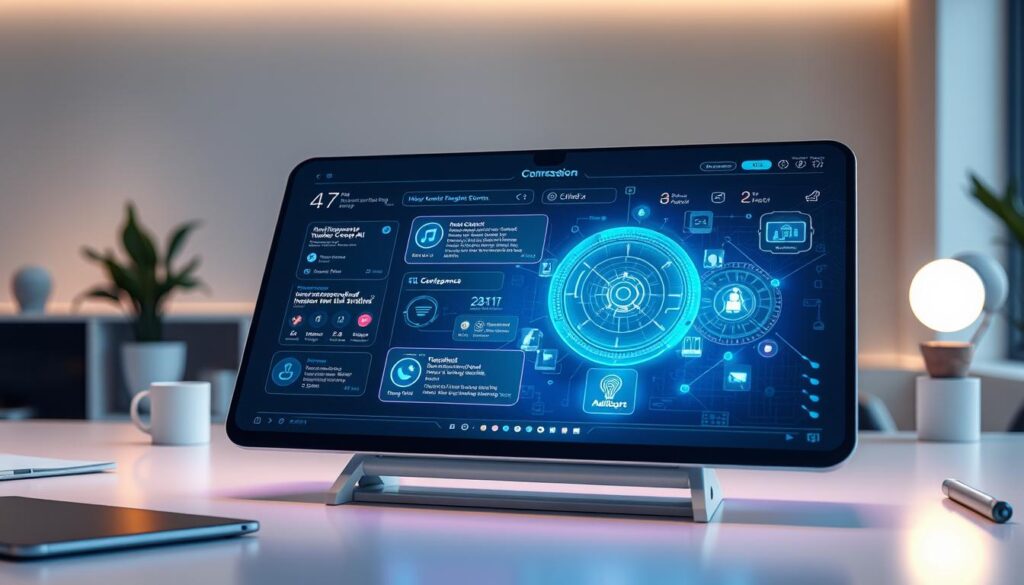
Gesture Recognition and Computer Vision
AI is also changing how we use devices. We can now control them with hand movements and body gestures. This is really cool in virtual and augmented reality, where it makes experiences feel real.
Adaptive and Personalized User Experiences
AI in HCI is amazing because it learns and adapts. Machine learning algorithms study how we act to make interfaces that fit our needs. This is great for people with disabilities, as AI can adjust to help them better.
- Smart content tailored to preferences
- Responsive interfaces that adapt in real-time
- Engaging experiences based on user behavior
As AI keeps getting better, we’ll see even more cool things in HCI. We’ll have smart spaces that know what we need and interfaces that get our emotions. The future of how we interact with computers is very promising.
Ethical Considerations and Challenges in AI-HCI Integration
Exploring human-ai collaboration, I see big ethical hurdles. AI in HCI brings up privacy and data security issues. AI systems gather lots of user data, which can be good or bad.
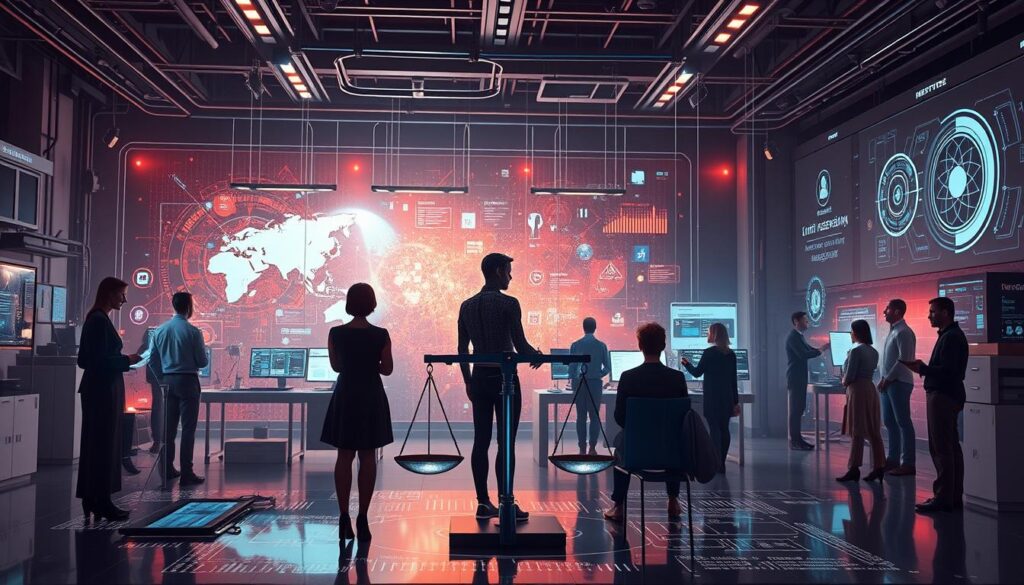
Bias in AI algorithms is a big worry. These biases can cause unfair results, affecting different groups. We must find and fix these biases to treat everyone fairly. Being open and clear about AI systems is key to gaining trust.
Understanding human behavior is hard for AI. Our actions are not always easy to predict. This makes it tough for AI to react right in every situation. We need AI systems that can adapt to many human behaviors.
- Privacy and data security concerns
- Potential for algorithmic bias
- Need for transparency and accountability
- Challenges in handling complex human behavior
To progress responsibly, we must tackle these ethical issues directly. This way, AI in HCI can help everyone, making digital experiences better. The future of human-ai collaboration relies on solving these challenges wisely and ethically.
Conclusion: The Future Landscape of AI in Human-Computer Interaction
I’m excited about the future of AI in how we use technology. AI is changing how we interact with tech in big ways. Voice recognition has improved a lot, making it easy to talk to AI helpers like Siri and Alexa.
These helpers use smart language to answer our questions fast. Gesture recognition is also changing things, moving beyond just touchscreens. It’s being used in healthcare, cars, and factories.
AI-powered interfaces are making tech easier for everyone to use. Imagine controlling your smart home with a wave or guiding a robotic surgeon with hand motions. The possibilities are endless.
Human-AI teamwork is becoming more common at work. Tools like Microsoft Teams use AI to improve how we communicate. Studies show AI teammates can help include more voices, making teamwork better.
As AI gets smarter, it will likely make experiences more personal. But, we can’t ignore the challenges ahead. Privacy, bias in AI, and ethics are big concerns.
We need to balance innovation with responsible AI use. By focusing on design that puts humans first, we can make AI that truly improves our lives. This way, AI and humans can work together, respecting each other’s values.
Source Links
- AI and Human-Computer Interaction
- What is AI in Human-Computer Interaction?
- AI and Human-Computer Interaction – 1Ansah Technologies
- What is Human-Computer Interaction (HCI)? – Spiceworks
- What is Human-Computer Interaction (HCI)?
- Multimodal Magic: Why AI is Revolutionizing Human-Computer Interaction for the Better
- Introduction to this special issue on unifying human computer interaction and artificial intelligenc
- Publications – Meta Research
- How AI Could Soon Take Human-Computer Interaction to New Levels – GeeksforGeeks
- Artificial Intelligence: Human-computer Interaction Methodologies – Artificial Intelligence – INTERMEDIATE – Skillsoft
- The Role of AI in Enhancing User Experience through Content
- Toward human-centered AI: A perspective from human-computer interaction
- Ethics and System Design in a New Era of Human–Computer Interaction – IEEE Technology and Society
- How does AI impact human-computer interaction?
- The Future of AI in Human-Computer Interaction: Advancements in Voice and Gesture Recognition
- AI and Human-Computer Interaction: A New Era of Collaboration
- A Literature Review on Current Trends in Human-AI Interaction
